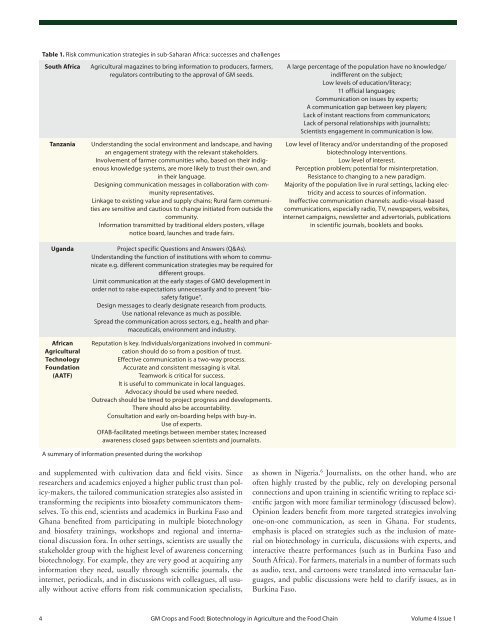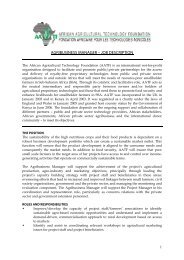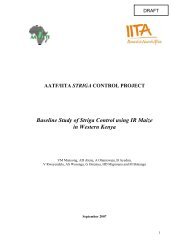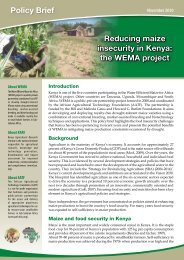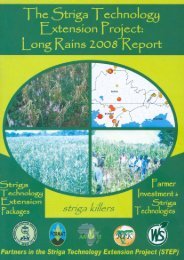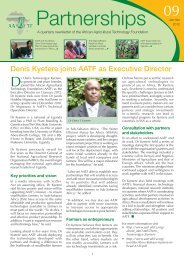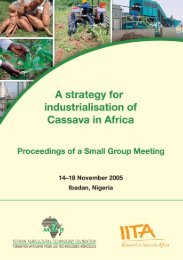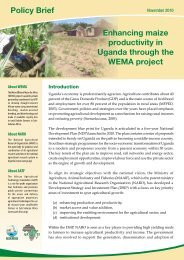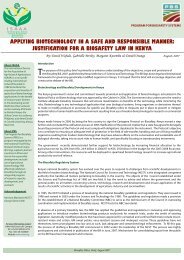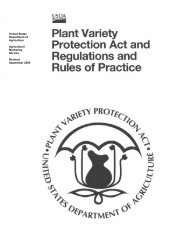Experiences in sub-Saharan Africa with GM crop risk communication
Experiences in sub-Saharan Africa with GM crop risk communication
Experiences in sub-Saharan Africa with GM crop risk communication
You also want an ePaper? Increase the reach of your titles
YUMPU automatically turns print PDFs into web optimized ePapers that Google loves.
Table 1. Risk <strong>communication</strong> strategies <strong>in</strong> <strong>sub</strong>-<strong>Saharan</strong> <strong>Africa</strong>: successes and challenges<br />
South <strong>Africa</strong><br />
Tanzania<br />
Uganda<br />
<strong>Africa</strong>n<br />
Agricultural<br />
Technology<br />
Foundation<br />
(AATF)<br />
Agricultural magaz<strong>in</strong>es to br<strong>in</strong>g <strong>in</strong>formation to producers, farmers,<br />
regulators contribut<strong>in</strong>g to the approval of <strong>GM</strong> seeds.<br />
Understand<strong>in</strong>g the social environment and landscape, and hav<strong>in</strong>g<br />
an engagement strategy <strong>with</strong> the relevant stakeholders.<br />
Involvement of farmer communities who, based on their <strong>in</strong>digenous<br />
knowledge systems, are more likely to trust their own, and<br />
<strong>in</strong> their language.<br />
Design<strong>in</strong>g <strong>communication</strong> messages <strong>in</strong> collaboration <strong>with</strong> community<br />
representatives.<br />
L<strong>in</strong>kage to exist<strong>in</strong>g value and supply cha<strong>in</strong>s; Rural farm communities<br />
are sensitive and cautious to change <strong>in</strong>itiated from outside the<br />
community.<br />
Information transmitted by traditional elders posters, village<br />
notice board, launches and trade fairs.<br />
Project specific Questions and Answers (Q&As).<br />
Understand<strong>in</strong>g the function of <strong>in</strong>stitutions <strong>with</strong> whom to communicate<br />
e.g. different <strong>communication</strong> strategies may be required for<br />
different groups.<br />
Limit <strong>communication</strong> at the early stages of <strong>GM</strong>O development <strong>in</strong><br />
order not to raise expectations unnecessarily and to prevent “biosafety<br />
fatigue”.<br />
Design messages to clearly designate research from products.<br />
Use national relevance as much as possible.<br />
Spread the <strong>communication</strong> across sectors, e.g., health and pharmaceuticals,<br />
environment and <strong>in</strong>dustry.<br />
Reputation is key. Individuals/organizations <strong>in</strong>volved <strong>in</strong> <strong>communication</strong><br />
should do so from a position of trust.<br />
Effective <strong>communication</strong> is a two-way process.<br />
Accurate and consistent messag<strong>in</strong>g is vital.<br />
Teamwork is critical for success.<br />
It is useful to communicate <strong>in</strong> local languages.<br />
Advocacy should be used where needed.<br />
Outreach should be timed to project progress and developments.<br />
There should also be accountability.<br />
Consultation and early on-board<strong>in</strong>g helps <strong>with</strong> buy-<strong>in</strong>.<br />
Use of experts.<br />
OFAB-facilitated meet<strong>in</strong>gs between member states; Increased<br />
awareness closed gaps between scientists and journalists.<br />
A large percentage of the population have no knowledge/<br />
<strong>in</strong>different on the <strong>sub</strong>ject;<br />
Low levels of education/literacy;<br />
11 official languages;<br />
Communication on issues by experts;<br />
A <strong>communication</strong> gap between key players;<br />
Lack of <strong>in</strong>stant reactions from communicators;<br />
Lack of personal relationships <strong>with</strong> journalists;<br />
Scientists engagement <strong>in</strong> <strong>communication</strong> is low.<br />
Low level of literacy and/or understand<strong>in</strong>g of the proposed<br />
biotechnology <strong>in</strong>terventions.<br />
Low level of <strong>in</strong>terest.<br />
Perception problem; potential for mis<strong>in</strong>terpretation.<br />
Resistance to chang<strong>in</strong>g to a new paradigm.<br />
Majority of the population live <strong>in</strong> rural sett<strong>in</strong>gs, lack<strong>in</strong>g electricity<br />
and access to sources of <strong>in</strong>formation.<br />
Ineffective <strong>communication</strong> channels: audio-visual-based<br />
<strong>communication</strong>s, especially radio, TV, newspapers, websites,<br />
<strong>in</strong>ternet campaigns, newsletter and advertorials, publications<br />
<strong>in</strong> scientific journals, booklets and books.<br />
A summary of <strong>in</strong>formation presented dur<strong>in</strong>g the workshop<br />
and supplemented <strong>with</strong> cultivation data and field visits. S<strong>in</strong>ce<br />
researchers and academics enjoyed a higher public trust than policy-makers,<br />
the tailored <strong>communication</strong> strategies also assisted <strong>in</strong><br />
transform<strong>in</strong>g the recipients <strong>in</strong>to biosafety communicators themselves.<br />
To this end, scientists and academics <strong>in</strong> Burk<strong>in</strong>a Faso and<br />
Ghana benefited from participat<strong>in</strong>g <strong>in</strong> multiple biotechnology<br />
and biosafety tra<strong>in</strong><strong>in</strong>gs, workshops and regional and <strong>in</strong>ternational<br />
discussion fora. In other sett<strong>in</strong>gs, scientists are usually the<br />
stakeholder group <strong>with</strong> the highest level of awareness concern<strong>in</strong>g<br />
biotechnology. For example, they are very good at acquir<strong>in</strong>g any<br />
<strong>in</strong>formation they need, usually through scientific journals, the<br />
<strong>in</strong>ternet, periodicals, and <strong>in</strong> discussions <strong>with</strong> colleagues, all usually<br />
<strong>with</strong>out active efforts from <strong>risk</strong> <strong>communication</strong> specialists,<br />
as shown <strong>in</strong> Nigeria. 6 Journalists, on the other hand, who are<br />
often highly trusted by the public, rely on develop<strong>in</strong>g personal<br />
connections and upon tra<strong>in</strong><strong>in</strong>g <strong>in</strong> scientific writ<strong>in</strong>g to replace scientific<br />
jargon <strong>with</strong> more familiar term<strong>in</strong>ology (discussed below).<br />
Op<strong>in</strong>ion leaders benefit from more targeted strategies <strong>in</strong>volv<strong>in</strong>g<br />
one-on-one <strong>communication</strong>, as seen <strong>in</strong> Ghana. For students,<br />
emphasis is placed on strategies such as the <strong>in</strong>clusion of material<br />
on biotechnology <strong>in</strong> curricula, discussions <strong>with</strong> experts, and<br />
<strong>in</strong>teractive theatre performances (such as <strong>in</strong> Burk<strong>in</strong>a Faso and<br />
South <strong>Africa</strong>). For farmers, materials <strong>in</strong> a number of formats such<br />
as audio, text, and cartoons were translated <strong>in</strong>to vernacular languages,<br />
and public discussions were held to clarify issues, as <strong>in</strong><br />
Burk<strong>in</strong>a Faso.<br />
4 <strong>GM</strong> Crops and Food: Biotechnology <strong>in</strong> Agriculture and the Food Cha<strong>in</strong> Volume 4 Issue 1


